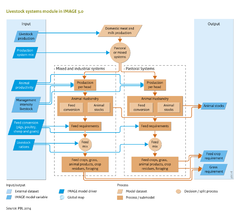Livestock systems: Difference between revisions
Jump to navigation
Jump to search
No edit summary |
No edit summary |
||
| Line 8: | Line 8: | ||
|Description=Food production will have to increase in order to feed the world’s growing population. However, with increasing prosperity and falling production costs, dietary patterns are shifting to include a higher proportion of meat and milk. In the last few decades, traditional mixed farming systems have not been able to raise production levels sufficiently to meet increasing demand. Consequently, modern livestock production systems are expanding rapidly particularly for poultry and pork, creating growing demand for feed crops. This trend started in high-income countries and is now observed in emerging and developing countries ([[Alexandratos and Bruinsma, 2012]]). | |Description=Food production will have to increase in order to feed the world’s growing population. However, with increasing prosperity and falling production costs, dietary patterns are shifting to include a higher proportion of meat and milk. In the last few decades, traditional mixed farming systems have not been able to raise production levels sufficiently to meet increasing demand. Consequently, modern livestock production systems are expanding rapidly particularly for poultry and pork, creating growing demand for feed crops. This trend started in high-income countries and is now observed in emerging and developing countries ([[Alexandratos and Bruinsma, 2012]]). | ||
Interactions between crop and livestock production are described in the livestock systems module of IMAGE, and also the consequences of changing practices in livestock farming for production of food crops and grass. For this purpose, IMAGE distinguishes pastoral livestock systems, and mixed and landless (industrial) production systems. Pastoral systems are based on grazing ruminants, while mixed and landless systems integrate crop and livestock production in which livestock are fed a mix of crops, crop by-products, grass, fodder and crop residues ([[Bouwman et al., 2005; Bouwman et al., 2006]]). | Interactions between crop and livestock production are described in the livestock systems module of IMAGE, and also the consequences of changing practices in livestock farming for production of food crops and grass. For this purpose, IMAGE distinguishes pastoral livestock systems, and mixed and landless (industrial) production systems. Pastoral systems are based on grazing ruminants, while mixed and landless systems integrate crop and livestock production in which livestock are fed a mix of crops, crop by-products, grass, fodder and crop residues ([[Bouwman et al., 2005]]; [[Bouwman et al., 2006]]). | ||
Livestock production is related to a wide range of the environmental issues, and the consequences of changes in the livestock system can be studied in the IMAGE: | Livestock production is related to a wide range of the environmental issues, and the consequences of changes in the livestock system can be studied in the IMAGE: | ||
Revision as of 16:39, 5 May 2014
Parts of Livestock systems
| Component is implemented in: |
| Components: |
| Related IMAGE components |
| Projects/Applications |
|
| Models/Databases |
| Key publications |
| References |
Key policy issues
- What are the impacts of increasing livestock production on land use, greenhouse gases and other emissions to air and surface water?
- How does the use of marginal lands for grazing increase the risk of degradation and loss of productivity, inducing more forest clearing?
